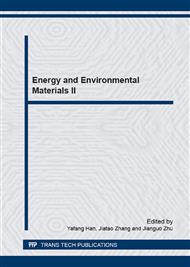[1]
L. Zhang, X.H. Qu, X.B. He, B.H. Duan, S.B. Ren, M.L. Qin, Thermo-physical and mechanical properties of high volume fraction SiCp/Cu composites prepared by pressureless infiltration, Mater. Sci. Eng. A. 489(2008) 285-293.
DOI: 10.1016/j.msea.2007.12.028
Google Scholar
[2]
K.M. Shu, G. C. Tu, The microstructure and the thermal expansion characteristics of Cu/SiCp composites, Mater. Sci. Eng., A. 349(2003) 236-247.
DOI: 10.1016/s0921-5093(02)00788-8
Google Scholar
[3]
H.R. Akramifard, M. Shamanian, M. Sabbaghian, M. Esmailzadeh, Microstructure and mechanical properties of Cu/SiC metal matrix composite fabricated via friction stir processing, Mater. Des. 54 (2014) 838–844.
DOI: 10.1016/j.matdes.2013.08.107
Google Scholar
[4]
S. Li, D.G. Xiong, M. Liu, S.X. Bai, X. Zhao, Thermophysical properties of SiC/Al composites with three dimensional interpenetrating network structure, Ceram. Int. 40(2014) 7539–7544.
DOI: 10.1016/j.ceramint.2013.12.105
Google Scholar
[5]
X.D. Liu, J.S. Zhang, X.M. Cao, H. Zhang, Finite element simulation of the thermal properties of particulate and continuous network-reinforced metal-matrix composites, Proc. Inst. Mech. Eng. Part B J. Eng. Manuf. 219(2005) 111-121.
DOI: 10.1243/095440505x8055
Google Scholar
[6]
J.C. Chen, C.Y. Hao, J.S. Zhang, Fabrication of 3D-SiC network reinforced aluminum–matrix composites by pressureless infiltration, Mater. Lett. 60(2006) 2489-2492.
DOI: 10.1016/j.matlet.2006.01.027
Google Scholar
[7]
S.B. Ren, X.H. Qu, J. Guo, X.B. He, M.L. Qin, X.Y. Shen, Net-shape forming and properties of high volume fraction SiCp/Al composites, J. Alloys Compd. 484 (2009) 256-262.
DOI: 10.1016/j.jallcom.2009.04.074
Google Scholar
[8]
Y.H. Dong, X.B. He, L. Xu, X.H. Qu, Fabrication and thermal conductivity of near-net-shaped diamond/copper composites by pressureless infiltration, J. Mater. Sci. 46(2011) 3862-3867.
DOI: 10.1007/s10853-011-5307-0
Google Scholar
[9]
J.W. Liu, Z.X. Zheng, J.M. Wang, Y. C Wu, W. M Tang, Pressureless infiltration of liquid aluminum alloy into SiC performs to form near-net-shape SiC/Al composites, J. Alloys Compd. 465 (2008) 239-243.
DOI: 10.1016/j.jallcom.2007.10.055
Google Scholar
[10]
C. Rado, B. Drevet, N. Eustathopoulos, The role of compound formation in reactive wetting: the Cu/SiC system, Acta Mater. 48(2000) 4483-4491.
DOI: 10.1016/s1359-6454(00)00235-4
Google Scholar
[11]
O. Dezellus, F. Hodaj, C. Rado, J.N. Barbier, N. Eustathopoulos, Spreading of Cu–Si alloys on oxidized SiC in vacuum: experimental results and modeling, Acta Mater. 50 (2002) 979-991.
DOI: 10.1016/s1359-6454(01)00397-4
Google Scholar
[12]
Y. Pan, X.S. Yi, J.L. Baptista, Kinetic Study of cobalt silicide infiltration into silicon carbide preforms, J. Am. Ceram. Soc. 82(1999) 3459–3465.
DOI: 10.1111/j.1151-2916.1999.tb02265.x
Google Scholar
[13]
G. P. Martins, D. L. Olson, G. R. Edwards, Modeling of infiltration kinetics for liquid-metal processing of composites, Metall. Trans. B. 19B (1988) 95-101.
DOI: 10.1007/bf02666495
Google Scholar
[14]
S. Gruner, W. Hoyer, The dynamic viscosity of liquid Cu-Si alloys, J. Alloys Compd. 460 (2008) 496-499.
DOI: 10.1016/j.jallcom.2007.05.083
Google Scholar
[15]
A. Masayoshi, S. Michael, B. Juergen, E. Ivan, W. Masahito, Surface tension and density measurement of liquid Si–Cu binary alloys, J. Mater. Sci. 45(2010) 2002-(2008).
Google Scholar
[16]
J. Narciso, L. Weber, J. M. Molina, A. Mortensen, E. Louis, Reactivity and thermal behaviour of Cu–Si/SiC composites: effects of SiC oxidation, Mater. Sci. Technol. 22(2006) 1464-1468.
DOI: 10.1179/174328406x131000
Google Scholar


